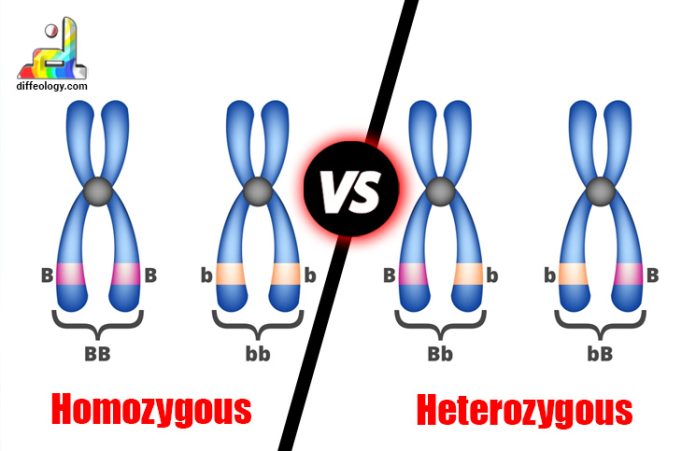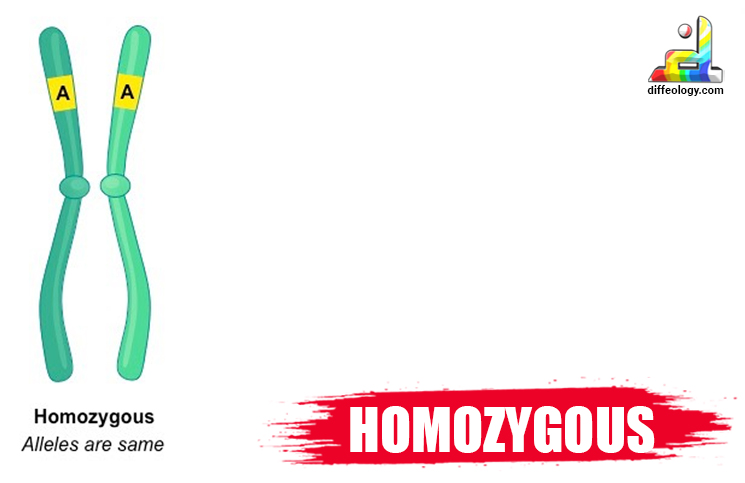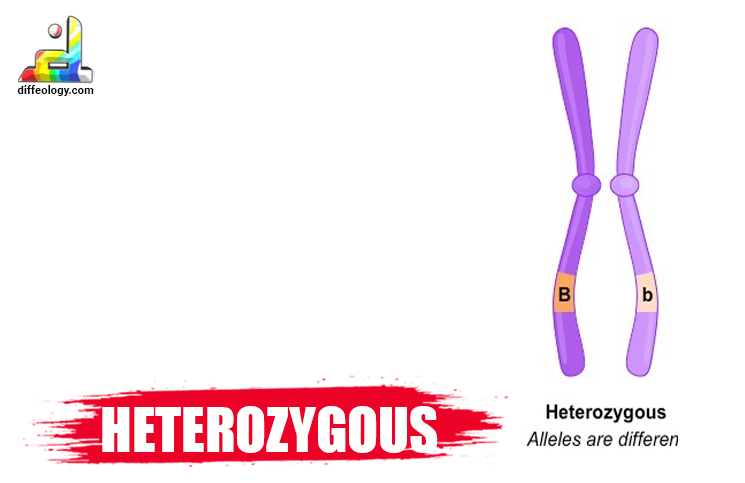Homozygous and heterozygous are terms used in genetics to describe the combination of alleles for a particular gene. Understanding the Difference Between Homozygous and Heterozygous is crucial in comprehending how traits are inherited in living organisms.
Homozygous individuals possess two identical alleles for a specific trait. It means that both gene copies are the same, either dominant or recessive. In contrast, heterozygous individuals have two different alleles for the same trait. One allele is inherited from each parent, leading to a mix of genetic information.
The Main Difference Between Homozygous and Heterozygous
Homozygous individuals carry two identical alleles, whereas heterozygous individuals possess different alleles. Homozygotes express dominant or recessive traits exclusively, while heterozygotes display a combination of both traits.
Homozygosity results in lower genetic diversity, whereas heterozygosity increases genetic diversity. Homozygous traits are inherited as a whole, while heterozygous traits involve the inheritance of both alleles.
Homozygous crosses follow strict Mendelian ratios, producing offspring with predictable genotype ratios, while heterozygous crosses can result in more varied genotypic outcomes. Homozygous individuals may be more susceptible to the impact of deleterious mutations, as they lack a different allele to potentially compensate, whereas heterozygous individuals may show more resilience.
Homozygous Vs. Heterozygous
What is Homozygous?
Homozygous is a term used in genetics to describe an organism that has identical alleles for a specific trait. Alleles are different forms of a gene, and each individual inherits two alleles for each gene – one from each parent. When an organism is homozygous for a particular trait, it means that both of its alleles for that trait are the same. This condition can occur when an organism inherits identical alleles from both biological parents.
To understand this better, let’s consider an example. If a plant has two identical alleles for the gene determining flower color, say both alleles code for purple flowers, then the plant is homozygous for that trait. On the other hand, if it has one allele for purple flowers and one for white flowers, it is heterozygous. The term homozygous is fundamental in understanding the genetic makeup of individuals and plays a crucial role in the inheritance of traits from one generation to the next.
Read Also: Difference Between Living and Non Living Things
In human genetics, being homozygous doesn’t necessarily mean having identical physical characteristics. It simply implies that for a specific gene or trait, the genetic information carried by the alleles is the same. This concept is essential in various fields, from agriculture, where it influences crop breeding, to medicine, where understanding genetic variations is vital for diagnosing and treating certain conditions.
What is Heterozygous?
Heterozygous is a term used in genetics to describe the state in which an organism has inherited different forms of a specific gene from each biological parent. In simpler terms, it means that the alleles, which are different versions of a gene, at a particular gene locus are unlike. This condition arises when an individual inherits one dominant allele and one recessive allele for a given trait.
To illustrate, let’s consider a gene responsible for eye color. If an individual is heterozygous for this gene, they might inherit one allele for brown eyes (dominant) from one parent and another allele for blue eyes (recessive) from the other parent. The dominant allele often masks the expression of the recessive allele, determining the individual’s observable trait – in this case, brown eyes.
Read Also: Difference Between Paracetamol and Ibuprofen
Understanding heterozygosity is crucial in genetics as it influences the diversity of traits within a population. It plays a vital role in the inheritance patterns of genes and contributes to the genetic variation seen in offspring. This diversity is a result of the different combinations of alleles inherited from each parent, contributing to the complexity and uniqueness of an individual’s genetic makeup.
Comparison Table “Homozygous Vs. Heterozygous”
| Definition | Inherit identical alleles. | Inherit different alleles. |
| Allele Possession | Carries either dominant or recessive alleles. | Possesses both dominant and recessive alleles. |
| Gene Copies | Has the same two gene copies. | Has different gene copies. |
| Genetic Makeup | Has identical genetic makeup for a trait. | Has a diverse genetic makeup for the trait. |
| Punnett Square | Results in uniform Punnett square outcomes. | Creates varied Punnett square outcomes. |
| Trait Expression | Traits express uniformly. | Traits may show dominant or recessive expression. |
| Pure Breeding | Contributes to pure breeding. | Contributes to genetic diversity. |
| Recessive Alleles | Recessive individuals exhibit the trait. | Carries the recessive allele but may not express it. |
| Dominant Alleles | Dominant individuals always express the trait. | Expresses the dominant trait. |
| Genetic Diversity | Reduces genetic diversity. | Increases genetic diversity. |
| Inheritance Probability | Predictable inheritance pattern. | Varied inheritance pattern. |
| Genotype Homogeneity | Genotype is homogeneous. | Genotype is heterogeneous. |
| Genetic Stability | Contributes to genetic stability. | Introduces genetic variability. |
| Mutation Impact | It may amplify the impact of deleterious mutations. | It can mask the effect of recessive mutations. |
| Resilience | May lack resilience to changing environments. | May exhibit increased resilience. |
| Selective Advantage | Traits may confer a selective advantage in stable environments. | Traits may offer a selective advantage in changing environments. |
| Genetic Disorders | Individuals may show genetic disorders. | Individuals may be carriers without showing symptoms. |
| Evolutionary Perspective | It may play a role in rapid adaptation. | Contributes to long-term evolutionary processes. |
Difference Between Homozygous and Heterozygous in Detail
1. Definition and Composition
Homozygous refers to an organism having identical alleles for a specific gene on both chromosomes, whether they are dominant or recessive. In contrast, heterozygous describes an organism with different alleles for a particular gene on its chromosome pairs. This difference in allele composition is crucial for understanding how genetic traits are inherited.
Homozygous individuals have either two dominant alleles or two recessive alleles, resulting in a uniform expression of the associated trait. On the other hand, heterozygous individuals possess one dominant and one recessive allele, leading to a more diverse range of trait expressions. This distinction in genetic makeup plays a fundamental role in the diversity observed within a population.
2. Inheritance Patterns
The mode of inheritance differs between homozygous and heterozygous individuals. Homozygous traits are inherited consistently within a population, maintaining stability. In contrast, heterozygous traits show a broader range of phenotypic variations as the dominant allele masks the expression of the recessive allele. This leads to a more complex inheritance pattern.
Understanding inheritance is crucial in predicting the likelihood of specific traits appearing in offspring. Homozygous parents are more likely to pass on uniform traits, while heterozygous parents can contribute to a diverse set of traits in their progeny.
3. Genetic Diversity and Adaptation
Homozygosity tends to reduce genetic diversity within a population due to the consistent expression of traits. In contrast, heterozygosity contributes to increased genetic diversity, offering populations a better chance to adapt to changing environments. This diversity is essential for the long-term survival and evolution of a species.
In nature, both homozygous and heterozygous individuals play critical roles. Homozygous traits provide stability, while heterozygous traits offer flexibility and adaptability. The interplay between these genetic variations is a driving force in the evolution and sustainability of life on Earth.
4. Allele Representation
Homozygous individuals represent either a pair of dominant alleles (homozygous dominant) or a pair of recessive alleles (homozygous recessive). This results in a clear and consistent expression of the associated trait, whether it be a physical characteristic or a biochemical process. In contrast, heterozygous individuals carry both a dominant and a recessive allele, showcasing a combination of traits.
Understanding allele representation is crucial for predicting the outcomes of genetic crosses. Homozygous crosses typically yield uniform offspring, while heterozygous crosses produce a diverse set of phenotypes.
5. Phenotypic Expression
Homozygous individuals exhibit a clear and predictable phenotypic expression, as both alleles contribute to the same trait. In heterozygous individuals, the dominant allele masks the recessive one, resulting in a phenotype determined by the dominant allele. However, the recessive allele is not lost; it can reappear in subsequent generations when two heterozygous individuals mate.
This difference in phenotypic expression is a key factor in understanding the observable characteristics of organisms and predicting the outcomes of genetic crosses.
6. Genetic Stability
Homozygosity contributes to genetic stability by maintaining consistent traits within a population. In contrast, heterozygosity introduces variability, which can be advantageous for species facing environmental changes. The balance between genetic stability and adaptability is crucial for the survival of populations over time.
This genetic stability in homozygous individuals is evident in traits that have been preserved over generations, providing a foundation for understanding the historical aspects of a species.
7. Genetic Disorders
Homozygous individuals carrying two copies of a recessive allele for a particular gene may express genetic disorders associated with that allele. Heterozygous individuals, carrying one dominant and one recessive allele, usually do not show symptoms of the disorder. However, they can pass on the recessive allele to their offspring, potentially leading to the expression of the disorder in the next generation.
This aspect is crucial in understanding the transmission of genetic disorders within families and populations.
8. Genetic Makeup
Homozygous individuals possess identical alleles for a specific gene, either two dominant alleles (homozygous dominant) or two recessive alleles (homozygous recessive). This uniformity ensures that the expressed trait is consistent. In contrast, heterozygous individuals carry one dominant and one recessive allele for a particular gene. This diversity in allele composition leads to a combination of traits, as the dominant allele often masks the expression of the recessive one.
Understanding the genetic makeup is crucial for predicting how traits are inherited and expressed in offspring. Homozygosity guarantees a clear genetic outcome, while heterozygosity introduces variability in the expression of traits.
9. Gamete Formation
In terms of reproduction, homozygous individuals produce gametes (sperm or egg cells) that carry only one type of allele. If an organism is homozygous for a dominant trait, all its gametes will carry the dominant allele. Conversely, if it’s homozygous recessive, all gametes will carry the recessive allele. Heterozygous individuals, however, produce gametes with a mix of alleles – half carry the dominant allele, and half carry the recessive allele.
This distinction in gamete formation plays a vital role in genetic diversity. Homozygous reproduction maintains the consistency of traits, while heterozygous reproduction introduces variability.
10. Mendelian Inheritance
Homozygous traits follow Mendelian inheritance patterns more predictably. If both parents are homozygous for a trait, their offspring will inherit the same alleles, ensuring a stable expression of that trait. Heterozygous traits, on the other hand, involve the interaction of dominant and recessive alleles, leading to a broader range of phenotypic outcomes.
Understanding Mendelian inheritance is essential in genetics, as it provides a framework for predicting the probability of specific traits appearing in offspring based on the parent’s genetic makeup.
11. Gene Expression
In homozygous individuals, the gene expression is straightforward and consistent. If the organism is homozygous dominant, the dominant allele determines the expressed trait. In contrast, heterozygous individuals have a more complex gene expression pattern. The dominant allele masks the expression of the recessive allele, resulting in a phenotype determined by the dominant allele.
This Difference Between Homozygous and Heterozygous in gene expression contributes to the observable variations in traits among individuals within a population. Homozygous traits maintain purity, while heterozygous traits introduce a blend of characteristics.
12. Genetic Disorders
Homozygous recessive individuals are more susceptible to expressing genetic disorders associated with recessive alleles. If an organism inherits two copies of a recessive allele for a specific gene, it may exhibit the associated disorder. Heterozygous individuals, carrying one dominant and one recessive allele, typically do not show symptoms of the disorder. However, they can pass on the recessive allele to their offspring, potentially leading to the expression of the disorder in the next generation.
Understanding the association between genetic disorders and homozygous or heterozygous genetic makeup is crucial for predicting and managing inherited health conditions.
13. Genetic Stability and Adaptation
Homozygosity tends to contribute to genetic stability by maintaining consistent traits within a population. In contrast, heterozygosity introduces variability, which can be advantageous for species facing environmental changes. The balance between genetic stability and adaptability is crucial for the survival of populations over time.
This genetic stability in homozygous individuals is evident in traits that have been preserved over generations, providing a foundation for understanding the historical aspects of a species.
Key Points Difference Between Homozygous and Heterozygous
- Definition: Homozygous individuals have identical alleles for a specific gene, while heterozygous individuals have different alleles.
- Diploid Nature: Homozygotes have two identical alleles in their diploid cells, whereas heterozygotes have two different alleles.
- Recessive Expression: Homozygous recessive individuals express recessive traits, while heterozygous individuals carry the recessive allele without expressing it.
- Dominant Expression: Homozygous dominant individuals express dominant traits exclusively, while heterozygous individuals express both dominant and recessive traits.
- Mating Outcomes: Homozygous mating produces offspring with identical genotypes, while heterozygous mating results in diverse genotypes.
- Genetic Makeup: Homozygous individuals have a homozygous genetic makeup, while heterozygous individuals have a heterozygous genetic makeup.
- Genotype Variety: Homozygotes have limited genotype variety, while heterozygotes exhibit greater genotype variety.
- Risk of Genetic Disorders: Homozygosity increases the risk of expressing recessive genetic disorders, while heterozygosity often masks such disorders.
- Genetic Homogeneity: Homozygotes contribute to genetic homogeneity, while heterozygotes promote genetic heterogeneity.
- Mendelian Ratios: Homozygous crosses follow Mendelian ratios more strictly than heterozygous crosses.
- Genetic Stability: Homozygosity enhances genetic stability, while heterozygosity introduces genetic variability.
- Genetic Resilience: Heterozygosity provides resilience to environmental changes, while homozygosity may lack adaptability.
- Evolutionary Significance: Heterozygosity is considered evolutionarily advantageous due to increased adaptability and survival chances, while homozygosity may limit adaptability.
- Dominance Expression: Homozygous individuals express traits based on the dominance of the alleles, while heterozygous individuals may exhibit a blend of dominant and recessive traits.
- Genetic Makeup: Homozygotes have a consistent genetic makeup, containing either two dominant or two recessive alleles, whereas heterozygotes have a diverse genetic makeup with one dominant and one recessive allele.
- Selective Advantage: Heterozygosity can provide a selective advantage in changing environments due to the potential for a wider range of adaptive traits, while homozygosity may limit adaptability.
FAQs: Homozygous Vs. Heterozygous
Conclusion
The key difference between homozygous and heterozygous lies in their genetic makeup. Homozygous organisms carry identical alleles, imparting uniformity to a specific trait. On the other hand, heterozygous organisms exhibit genetic diversity as they inherit different alleles from each parent. This fundamental distinction is fundamental to our understanding of inheritance patterns and the diversity of traits within populations.






